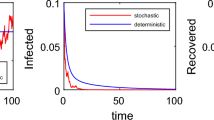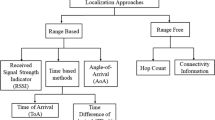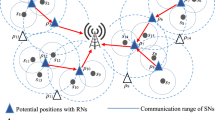Abstract
In Event-driven wireless systems, mostly data transmission depends on events occurring in the sensor field. Most of the time, sensor nodes are silent or in sleep mode. When events occur in the sensor field, a single event can trigger many nodes for data transmission. In such a scenario, the nodes collect the correlated information due to the overlapped coverage area. Existing epidemiological designs do not consider the nodes’ behavior to investigate infection dynamics for this scenario. In this paper, a susceptible-exposed-infectious-recovered- susceptible (SEIRS) is designed by considering the spatial correlation for analyzing the dynamics of the virus spreading in event-driven wireless systems. Firstly, we show how strongly correlated nodes and less correlated nodes are formed in a WSN based on sensor coverage. The differential equations of SEIRS are then derived. An analysis on system stability is performed for finding the basic reproduction number \(R_0\). The value of \(R_0\) gives important significance in terms of spatial correlation for analyzing virus spreading. Experiments are performed to validate the model using various parameters such as correlation, node density, the basic reproduction number. Comparisons with existing models show the effectiveness of the SEIRS model. Based on the analysis, it is observed that the virus spread control can be possible by reducing \(R_0\). It is also found that the threshold of virus propagation is strongly dependent on the spatial correlation between nodes in the network. The virus is the network persists at virus-free equilibrium when \(R_0 > 1\) with higher spatial correlation, whereas it becomes globally stable for \(R_0 < 1\).










Similar content being viewed by others
References
Akyildiz IF, Vuran MC (2010) Wireless sensor networks. Wiley
Allen LJ (1994) Some discrete-time SI SIR and SIS epidemic models. Math Biosci J 124(1):83–105. https://doi.org/10.1016/0025-5564(94)90025-6
Batista FK, Martín del Rey A, Queiruga-Dios A (2020) A new individual-based model to simulate malware propagation in wireless sensor networks. Mathematics 8(3):410
Del Ray AM (2015) Mathematical modeling of the propagation of malware: a review. J Secur Commun Netw 8(15):2561–2579
Feng L, Song L, Zhao Q, Wang H (2015) Modeling and stability analysis of worm propagation in wireless sensor network. Math Probl Eng Article ID 129598. https://doi.org/10.1155/2015/129598
Gao Q, Zhuang J (2020) Stability analysis and control strategies for worm attack in mobile networks via a VEIQS propagation model. Appl Math Comput 368, Article 124584
Geetha R, Madhusudanan V, Srinivas MN (2021) Influence of clamor on the transmission of worms in remote sensor network. Wirel Pers Commun 118:461–473
Guilln HJD, Del Rey AM (2017) SEIRS epidemic model with delay for transmission of malicious objects in computer network. Appl Math Comput 188(2):1476–1482
Guiyun L, Baihao P, Xiaojing Z, Xuejing L (2020) Differential games of rechargeable wireless sensor networks against malicious programs based on SILRD propagation model. Complexity, vol 2020, Article ID 5686413, 13
Hernández Guillén JD, Martín del Rey A (2019) A mathematical model for malware spread on WSNs with population dynamics. Stat Mech Its Appl Phys A 545
Jiang L, Xu Q, Pan H, Dai Y, Tong J (2020) Virus propagation in wireless sensor networks with media access control mechanism. Secur Commun Netw 11, Article ID 6513920
Ojha RP, Srivastava PK, Sanyal G (2019) Improving wireless sensor networks performance through epidemic model. Int J Electron 106(6):862–879
Ojha RP, Srivastava PK, Sanyal G et al (2021) Improved model for the stability analysis of wireless sensor network against malware attacks. Wirel Pers Commun 116:2525–2548
Qu B, Wang H (2017) SIS epidemic spreading with correlated heterogeneous infection rates. Phys A 472:13–24
Rao YS, Keshri AK, Mishra BK, Panda TC (2020) Distributed denial of service attack on targeted resources in a computer network for critical infrastructure: a differential e-epidemic model. Phys A Stat Mech Its Appl, Elsevier, 540(C)
Shakya RK, Singh YN, Verma NK (2013) Generic correlation model for wireless sensor network applications. J IET Wirel Sens Syst 3(4):266–276
Shakya RK, Rana K, Gaurav A, Mamoria P, Srivastava PK (2019) Stability analysis of epidemic modeling based on spatial correlation for wireless sensor networks. Int J Wirel Personal Commun Springer 106(3):1–15. https://doi.org/10.1007/s11277-019-06473-0
Shen S, Zhou H, Feng S, Liu J, Cao Q (2019) SNIRD: disclosing rules of malware spread in heterogeneous wireless sensor networks. IEEE Access 7:92881–92892
Singh A, Awasthi AK, Singh K, Srivastava PK (2018) Modeling and analysis of worm propagation in wireless sensor networks. Wirel Pers Commun 98(3):2535–2551
Srivastava PK, Pandey SP, Gupta N, Singh SP, Ojha RP (2019) Modeling and analysis of antimalware effect on wireless sensor network. IEEE 4th International conference on computer and communication systems (ICCCS), pp 639–643
Tang S (2011) A modified SI epidemic model for combating virus spread in wireless sensor networks. Int J Wirel Inf Netw 18:319–326. https://doi.org/10.1007/s10776-011-0147-z
Tang S, Myers D, Yuan J (2013) Modified SIS epidemic model for analysis of virus spread in wireless sensor networks. Int J Wirel Mob Comput 6(2):99–108. https://doi.org/10.1504/IJWMC.2013.054048
Wang T, Wu Q, Wen S et al (2017) Propagation modeling and defending of a mobile sensor worm in wireless sensor and actuator networks. Sensors 17(1):1–17
Xiao-Ping S, Yu-Rong SJ (2011) A malware propagation model in wireless sensor networks with cluster structure of GAF. J Telecommun Sci 27(8):33–38
Yonghua Z, Jianhua Z, Chaoan L (2020) A SEIQR Model considering the Effects of Different Quarantined Rates on Worm Propagation in Mobile Internet. Math Probl Eng, Article ID 8161595, 16 pages
Zhang Z, Kundu S, Wei R (2019) A delayed epidemic model for propagation of malicious codes in wireless sensor network. Mathematics 7(5):396
Zhang Z, Zou J, Ranjit Kumar U, Ghaus ur Rahman (2020) An epidemic model with multiple delays for the propagation of worms in wireless sensor networks. J Results Phys 19
Funding
This research received no specific grant from any funding agency in the public, commercial, or not-for-profit sectors.
Author information
Authors and Affiliations
Corresponding author
Ethics declarations
Conflict of interest
Rajeev Kumar Shakya, Tadesse Hailu Ayane, Feyissa Debo Diba, and Pushpa Mamoria declare that they have no conflict of interest.
Additional information
Publisher's Note
Springer Nature remains neutral with regard to jurisdictional claims in published maps and institutional affiliations.
Rights and permissions
About this article
Cite this article
Shakya, R.K., Ayane, T.H., Diba, F.D. et al. SEIRS model with spatial correlation for analyzing dynamic of virus spreading in event-driven wireless sensor networks. Int J Syst Assur Eng Manag 13, 752–760 (2022). https://doi.org/10.1007/s13198-021-01336-z
Received:
Revised:
Accepted:
Published:
Issue Date:
DOI: https://doi.org/10.1007/s13198-021-01336-z




